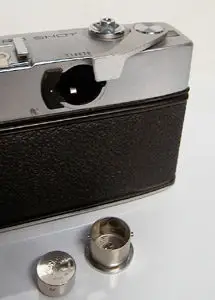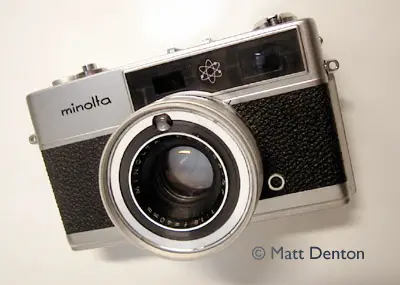- Produced 1965 Minolta Camera Co., Japan
- Film type 135 (35mm)
- Picture size 24mm x 36mm
- Weight 23.2oz (657.7g)
- Lens Rokkor-QF 40mm 1:1.8 (6 elements, ‘Achromatic’ double coating)
- Filter size 54mm screw-in, 57mm slip-on
- Focal range 2.6′ to infinity
- Shutter Seiko-ES
- Shutter speeds 1/15 – 1/500
- Viewfinder coupled rangefinder, bright line finder w/parallax marks
- Exposure meter lens mounted CdS, underexposure warning light in VF
- Auto EV range 5.6 to 17
- Battery Mallory RM1 1.3v (modern equivalent is PX1A)
- ASA 25-400
- Hotshoe, pc sync
- Flashmatic system using guide number settings
- Self-timer
- Battery check button
Overview
Nice fully automatic rangefinder with the venerable ‘Flashmatic’ system where you set the GN for the flash on the lens barrel and the camera figures out the aperture and shutter speed. Set to ‘Auto’ if no flash attached and… the camera figures out the aperture and shutter speed. Fast and sharp 1.8 coated Rokkor, nice bright rangefinder window, and the whole thing sleek, tight and just about the perfect size, which is to say exactly as big as the Yashica Electro 35. Not too bulky but you know you’re holding a camera. This camera is supposedly notable for being the first 35mm lens/shutter camera with an electronically-controlled aperture and shutter. It’s also got a very nice feel, it’s quite a pleasure to use.
Special note: this model, which is concurrent with the early Hi-Matics, is obscure enough that it took a few calls to Minolta to even find someone who has heard of it, but I eventually got someone at the corporate office (1-877-432-7933) who was able to look it up and fax me a data sheet. Nice people, those Minolta customer service folk. I even got a callback a week later just to make sure I got the information I was looking for, and all this without any money changing hands. I wish all companies were as helpful and friendly. Now that they’re out of the camera business altogether (after merging with Konica), I doubt they’re as helpful…
It’s a very nice-looking camera, with only one major (noticeable) design flaw: the battery compartment location is in the abolutely worst-designed spot I’ve ever seen. You literally have to click the shutter, partially cock the wind lever to move it out of the way, and then twist the ring-lock to remove the cylindrical battery holder. Unbelieveable.

Speaking of batteries, by the way, ‘fully automatic’ is another way of saying ‘battery-dependent’. I originally thought the camera was dead or had sticky shutter blades, since it did the old Canonet trick of going ‘click’ with no shutter movement. Then I reread the manual to find that the “shutter…is dependent on the completion of a circuit…” OK then.
I failed to get it to work with a 640KA (right width, wrong length), then looked a little harder and finally found the modern equivalent of the Mallory RM1 (other names: PX1, E1N, MR52, RM-1R, V1PX) as the A1PX. I think I’ve seen it elsewhere as the PX1A. At any rate, it’s about as big around as a 640 but longer. You could probably make do with a 640 and a spring but I didn’t try that now that I have the right one (yay!)
There is a battery check button on the side of the camera that lights up a light in the viewfinder. The same light comes on as a slow/flash warning if the light is insufficient for the meter’s exposure range.
Other notes: wind lever has the same 220° swing of the large Hi-Matics, why they kept it I don’t know, at least it’s geared so you can pump it multiple times. Another thing they kept is the ‘cut-away’ film chamber as they call it. ‘Standard 35mm film cartridge slides in without fumbling’ says the data sheet. It needs it as the rewind lever doesn’t lift up, so you need that extra room to slip the film cartridge in & out. On the other hand, the wind stroke is smoother and somehow slightly less annoying than on the Hi-Matic 7s.
Repairs
Something was rattling around inside, turned out to be a piece of rangefinder glass that needed regluing. Otherwise near perfect!
Tips & Tricks
The release for the back is a catch on the side — don’t try pulling up on the rewind knob, it doesn’t. Auto exposure means you have no control over DOF, so use fast film if you’re worried about getting everything sharp, or slower film if you’re interested in isolating subjects.
PS flash exposure is spot-on, have never had anything less with the Flashmatic system.
Related Links
- Minolta Users Group
- Hard to find film camera batteries at batteriesplus.com
